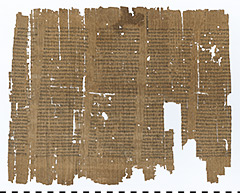P. 6926 R
Acts of a love story – these two papyrus fragments allow us to gain an insight into two different scenes of an ancient Greek novel, the oldest survivor of its genre. It is not possible anymore to determine precisely the author of these lines. At least some notes of an account on the back of the fragments, which were taken around 100 to 101 AD, allow us to suggest that the novel must have been written down several years or decades earlier to decrease in value to such a degree that the papyrus was finally used for taking notes.
Originally, both fragments belonged to the same scroll. On fragment A 5 columns have survived, of which the first and the last one are only half intact and the fourth one is interspersed with a gap in the lower area. Similarly, the two outer ones of the three columns on fragment B are not complete. Each column consists of about 38 lines; all the handwriting originates from the same writer.
It has not been determined yet if the plot of fragment A chronologically precedes that of fragment B or vice versa – there are various arguments for both views, but no deciding ones until now. Fragment A tells us about the wish of Ninus and Semiramis – a young couple of seventeen and thirteen – to get married, as Ninus is going to go on a military expedition. However, the girl is, according to tradition, two years too young for marriage. In order to fulfill their wish anyway, each of them turns to the mother of the other for help. While Ninus expresses his desire with superior ease, the girl does not manage to utter a sound because of her excitement, but is all tears, although the mothers are not averse to fulfilling their children´s wish. Therefore they decide to clarify things by a conversation. At this point – as the story becomes more dramatic – the papyrus breaks off. On fragment B the reader finds Ninus on a military campaign marching to Armenia with a huge army. Having arrived there, he gives a speech just before the decisive battle to encourage his soldiers.
Ninus and Semiramis – these are names less known from a novel, rather than from mythology: Ninus (who also appears under the name Nimrod) is the founder of Nineveh and Great King over almost the whole Near East. He takes away Onnes´, his governor´s, wife Semiramis and marries her himself. Semiramis on the other hand appears in the myth as an active woman with divine origin that conquers further parts of Asia and has Ninus completely under her spell. The mythological Semiramis is obviously the total opposite of her counterpart in the papyrus novel, where she is rather tearful and shy. Ninus too has fewer characteristics of an inconsiderate warrior but he appears as a virtuous hero as was necessary for a novel at that time.
Therefore, the papyrus fragments show how mythological stories could be altered by authors and – while conserving the basis of the narrative – could be changed completely. At the same time a change in literary history becomes tangible: Main characters that had been god-like heroes and supermen before were adapted over time to the milieu of average mortals and thus so to speak demythologized. The genre of novels became then increasingly popular in Imperial Rome.



